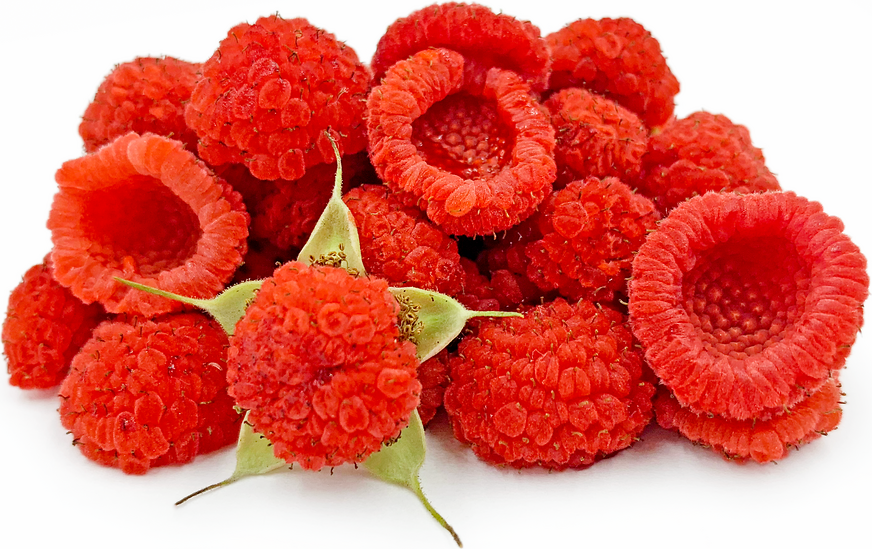


Thimble Berries
Estimated Inventory, lb : 0
Description/Taste
Thimbleberries are small, aggregate fruits, averaging 1 to 2 centimeters in diameter, and have a curved, domed appearance, similar to a raspberry but more flattened. The fruits are comprised of tiny, fleshy drupelets that encase many small, crunchy seeds, and have very thin, fuzzy, and delicate skin that ripens from white, pink, to bright red. The drupelets also form around a central core, and when harvested from the plant, the core is removed, creating a hollow, round cavity. Underneath the surface, the fruits have a soft and aqueous flesh combined with an unusual, velvety texture. Thimbleberries are aromatic and have a sweet-tart, fruity flavor followed by a musky, honeyed aftertaste. The shrub also bears notable, white crinkled flowers in the spring and large leaves, similar in appearance to a maple leaf, that are covered in soft, thick fuzz.
Seasons/Availability
Thimbleberries are available in the summer through early fall.
Current Facts
Thimbleberries, botanically a part of the Rubus genus, are small, wild drupes that grow on dense shrubs belonging to the Rosaceae family. There is some confusion surrounding the name Thimbleberry, as it is used to describe two closely related North American species, Rubus odoratus, the purple-flowering raspberry, and Rubus parviflorus. Though the name Thimbleberry may be used interchangeably for both, the species mainly associated with the name Thimbleberry, according to experts, is Rubus parviflorus. Thimbleberries are commonly found growing along roadsides, trails, and forest edges and are considered a wild species, not commercially cultivated. The fruits are known for having delicate, easily damaged skin and short shelf life, which has prevented the variety from being transported into mainstream markets. Despite their lack of commercial success, Thimbleberries are a popular home garden plant and are highly favored for their ornamental flowers and fruits. Thimbleberries are named for their resemblance to a sewing thimble and are primarily eaten fresh or cooked into preserves and syrups.
Nutritional Value
Thimbleberries are a good source of vitamins A and C, which are antioxidants that can strengthen the immune system, boost collagen production within the skin, and provide anti-inflammatory properties. In traditional medicines of Native Americans, the roots and leaves of the Thimbleberry were used in a tea to reduce symptoms associated with digestive issues. The tea was also applied topically to the skin to help with acne and wound healing.
Applications
Thimbleberries are best suited for both raw and cooked applications, such as baking or simmering. The fruits can be consumed fresh, out-of-hand, and many foragers eat the berries immediately for the best quality and flavor. Thimbleberries also begin to spoil hours after being harvested and have very delicate skin, making them difficult to transport. Beyond fresh eating, the fruits can be simmered into sauces and served with roasted meats, or the sauce can be poured over pancakes, waffles, and pastries and used as a topping over ice cream. The fruits can also be blended and strained into vinaigrettes, cooked into jams and jellies, juiced into cocktails, non-alcoholic beverages, and wine, or pressed and dried into fruit leather. In addition to the fruits, the young shoots can be peeled and eaten similarly to asparagus. Thimbleberries pair well with herbs such as rosemary, mint, thyme, and sage, meats including ham, duck, and poultry, honey, vanilla, and dark chocolate. Whole Thimbleberries should be consumed immediately after harvest for the best flavor and will only keep for 1 to 2 days when stored in the refrigerator.
Ethnic/Cultural Info
In the Upper Peninsula of Michigan, Thimbleberry jam has become a popular niche commodity sold in Keweenaw and Houghton counties. Thimbleberries grow well in Upper Michigan, and with their wide availability, harvesting the berries has remained a favorite social summer outing throughout the region. The sweet-tart fruits are primarily enjoyed fresh, out-of-hand, but due to the fruit’s short shelf life, they are also simmered with sugar to make jams. Thimbleberry jam-making was initially a home hobby, passed on between generations, but as more people became interested in the local preserves, some families decided to sell the jams for profit. Thimbleberries became especially popular for their rarity, and in 1979, the first Thimbleberry Blossom Festival was established in Michigan to celebrate the wild fruits. The festival is still celebrated today, now under the shortened name Thimbleberry Festival, and features many Thimbleberry desserts, including Thimbleberry sundaes, cookies, cakes, and ice cream. Thimbleberry jam-making has also expanded beyond personal use and has become a serious, additional source of income for Michigan residents. It is rumored that many jam makers have their own secret Thimbleberry patches and strive to keep them hidden to maintain a steady supply of the fruits.
Geography/History
Thimbleberries are native to regions across North America and have been growing wild since ancient times. The fruits were first recorded in 1818 by botanist Thomas Nuttall and were found on Michilimackinac Island in Lake Huron of the United States. Today Thimbleberries can still be found in temperate regions of North America, including Canada, New Mexico, Alaska, Montana, Colorado, the Dakotas, Wyoming, Idaho, and Washington, and have been spread naturally through seed scattering by wildlife. The shrubs are not commercially cultivated, but they have become a favored home garden variety, utilized for their dense, thick nature. Thimbleberries may be foraged from the wild or hand-harvested from specialty growers and found at local farmer’s markets.
Recipe Ideas
Recipes that include Thimble Berries. One
| Strudel & Streusel |
|
Thimbleberry Frozen Custard |
| Insteading |
|
Thimbleberry Dressing |
| Hilda's Kitchen Blog |
|
Thimbleberry White Chocolate Chip Cookies |
| Salon |
|
Thimbleberry Rosemary Simple Syrup |




